User:Retired User 44052/sandbox
Mission
[edit]National Aeronautics and Space Act
[edit]As outlined in 51 U.S.C. § 20102 and originally introduced in the National Aeronautics and Space Act, the United States Congress declared that that it is the policy of the United States that activities in space should be devoted to peaceful purposes for the benefit of all humankind.
It also designated NASA as the primary civilian aeronautical and space agency, except for activities primarily associated with the development of weapons systems, military operations, or the defense of the United States, including the research and development necessary to make effective provision for the defense of the United States, which is the responsibility of the Department of Defense and United States Space Force.
The ten Congressional objectives of aeronautics and space are:
- The expansion of human knowledge of the Earth and of phenomena in the atmosphere and space.
- The improvement of the usefulness, performance, speed, safety, and efficiency of aeronautical and space vehicles.
- The development and operation of vehicles capable of carrying instruments, equipment, supplies, and living organisms through space.
- The establishment of long-range studies of the potential benefits to be gained from, the opportunities for, and the problems involved in the utilization of aeronautical and space activities for peaceful and scientific purposes.
- The preservation of the role of the United States as a leader in aeronautical and space science and technology and in the application thereof to the conduct of peaceful activities within and outside the atmosphere.
- The making available to agencies directly concerned with national defense of discoveries that have military value or significance, and the furnishing by such agencies, to the civilian agency established to direct and control nonmilitary aeronautical and space activities, of information as to discoveries which have value or significance to that agency.
- Cooperation by the United States with other nations and groups of nations in work done pursuant to this chapter and in the peaceful application of the results thereof.
- The most effective utilization of the scientific and engineering resources of the United States, with close cooperation among all interested agencies of the United States in order to avoid unnecessary duplication of effort, facilities, and equipment.
- The preservation of the United States preeminent position in aeronautics and space through research and technology development related to associated manufacturing processes.
- The search for life’s origin, evolution, distribution, and future in the universe.
51 U.S.C. § 20112 outlines NASA's functions to:
- Plan, direct, and conduct aeronautical and space activities;
- Arrange for participation by the scientific community in planning scientific measurements and observations to be made through use of aeronautical and space vehicles, and conduct or arrange for the conduct of such measurements and observations;
- Provide for the widest practicable and appropriate dissemination of information concerning its activities and the results thereof;
- Seek and encourage, to the maximum extent possible, the fullest commercial use of space; and
- Encourage and provide for Federal Government use of commercially provided space services and hardware, consistent with the requirements of the Federal Government.
Strategy
[edit]NASA's most recent strategic plan, released in 2022, outlines four strategic goals:[1]
- Expand human knowledge through new scientific discoveries
- Extend human presence to the Moon and on towards Mars for sustainable long-term, exploration, development, and utilization
- Catalyze economic growth and drive innovation to address national challenges
- Enhance capabilities and operations to catalyze current and future mission success
History
[edit]Creating a civil aeronautics and space agency
[edit]
NASA traces its roots to the National Advisory Committee for Aeronautics (NACA). Despite being the birthplace of aviation, by 1914 the United States recognized that it was far behind Europe in aviation capability. Determined to regain American leadership in aviation, Congress created the Aviation Section of the U.S. Army Signal Corps in 1914 and established NACA in 1915 to foster aeronautical research and development. Over the next forty years NACA would conduct aeronautical research in support of the U.S. Air Force, its predecessors in the U.S. Army, the U.S. Navy, and the civil aviation sector. After the end of World War II, NACA became interested in the possibilities of guided missiles and supersonic aircraft, developing and testing the Bell X-1 in a joint program with the U.S. Air Force. NACA's interest in space grew out of its rocketry program at the Pilotless Aircraft Research Division. [2]

The Soviet Union's launch of Sputnik 1 ushered in the Space Age and kicked off the Space Race. Despite NACA's early rocketry program, the responsibility for launching the first American satellite fell to the Naval Research Laboratory's Project Vanguard. However, Project Vanguard was plauged by several issues and the Army Ballistic Missile Agency would launch Explorer 1, America's first satellite, on February 1, 1958.
The Eisenhower Administration decided to split the United States' military and civil spaceflight programs, which were organized together under Defense Department's Advanced Research Projects Agency. NASA was established on July 29, 1958 with the signing of the National Aeronautics and Space Act and it began operations on October 1, 1958.[3]
As the United States' premier aeronautics agency, NACA formed the core of NASA's new structure, absorbing its 8,000 employees and three major research laboratories. NASA also proceeded to absorb the Naval Research Laboratory's Project Vanguard, the Army's Jet Propulsion Laboratory, and the Army Ballistic Missile Agency under Wernher von Braun. This left NASA firmly as the United States' civil space lead and the Air Force as the military space lead.[4]
First orbital and hypersonic flights
[edit]
Plans for human spaceflight began in the U.S. Armed Forces prior to NASA's creation. The Air Force's Man in Space Soonest and the Army's Project Adam served as the foundation for Project Mercury, the first American program to put people in space. NASA established the Space Task Group to manage the program, which would conduct sub-orbital flights with the Army's Redstone rockets and orbital flights with the Air Force's Atlas launch vehicles. While NASA intended for its first astronauts to be civilians, President Eisenhower directed that they be selected from the military. The Mercury 7 astronauts included three Air Force pilots, three Navy aviators, and one Marine Corps pilot.[5]
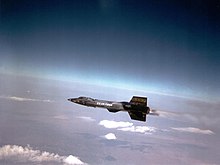
On May 5, 1961 Alan Shepard became the first American to enter space, performing a suborbital spaceflight in the Feedom 7. However, this flight occurred a less than a month after the Soviet Union's Yuri Gagarin became the first human in space, executing a full orbital spaceflight. NASA's first orbital spaceflight was conducted by John Glenn in the Friendship 7, conducting three full orbits before reentering. Glenn had to fly parts of his final two orbits manually due to a malfunction in the autopilot. The sixth and final Mercury mission was flown by Gordon Cooper, performing 22 orbits over 34 hours in the Faith 7. The Mercury Program was a resounding success, achieving its objectives to orbit a human in space, develop tracking and control systems, and identify other issues associated with human spaceflight.[6]
While much of NASA's attention turned to space, it did not forget its aeronautics mission. Early aeronautics research attempted to build upon the X-1's supersonic flight to build an aircraft capable of hypersonic flight. The North American X-15 was a joint NASA-U.S. Air Force program, with the hypersonic test aircraft becoming the first non-dedicated spacecraft to cross from the atmosphere to outer space. The X-15 also served as a testbed for Apollo program technologies and ramjet and scramjet propulsion.[7]
Landing on the Moon
[edit]
Escalations in the Cold War between the United States and Soviet Union prompted President John F. Kennedy to charge NASA with landing Americans on the Moon by the end of the 1960s and installed James E. Webb as NASA administrator to achieve this goal. On May 25, 1961, President Kennedy openly declared this goal in his Urgent National Needs speech to the United States Congress, declaring:
"I believe this Nation should commit itself to achieving the goal, before this decade is out, of landing a man on the moon and returning him safely to earth. No single space project in this period will be more impressive to mankind, or more important for the long-range exploration of space; and none will be so difficult or expensive to accomplish."
Despite attacks on the goal of landing astronauts on the Moon from the former president Dwight Eisenhower and 1964 presidential candidate Barry Goldwater, President Kennedy was able to protect NASA's growing budget, of which 50% went directly to human spaceflight and it was later estimated that, at its height, 1 out of 20 Americans worked on some aspect of the Apollo Program.[8]
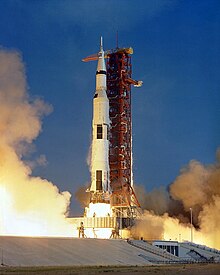
To manage the Apollo Program, NASA required a more rigorous approach than it applied to Project Mercury. Mirroring the Department of Defense's program management concept using redundant systems in building the first intercontinental ballistic missiles, NASA requested the Air Force assign Major General Samuel C. Phillips to the space agency where he would serve as the director of the Appollo Program. Development of the Saturn V rocket was led by Wernher von Braun and his team at the Marshall Space Flight Center, derived from the Army Ballistic Missile Agency's original Saturn I. The Apollo spacecraft was designed and built by North American Aviation, while the Apollo Lunar Module was designed and built by Grumman.[9]
To develop the spaceflight skills and equipment required for a lunar mission, NASA initiated Project Gemini. Using a modified Air Force Titan II launch vehicle, the Gemini capsule could hold two astronauts for flights of over two weeks. Gemini pioneered the use of fuel cells instead of legacy batteries and demonstrated spacewalks and rendezvous operations. NASA also needed more detained information about the Moon's geography and composition to prepare for a landing, using three uncrewed spacecraft programs.

The Ranger Program was started in the 1950s as a response to Soviet lunar exploration but was generally considered to be a failure. The Lunar Orbiter program had greater success, mapping the surface in preparation for Apollo landings and measured Selenography, conducted meteoroid detection, and measured radiation levels. The Surveyor program conducted uncrewed lunar landings and takeoffs, as well as taking surface and regolith observations.[10] Despite the setback caused by the Apollo 1 fire, which killed three astronauts, the program proceeded. Apollo 8 was the first circumlunar flight and the first lunar landing was conducted by Apollo 11. Commanded by Neil Armstrong with astronauts Buzz Aldrin and Michael Collins, Apollo 11 was one of the most significant missions in NASA's history, marking the end of the Space Race when the Soviet's gave up lunar ambitions. As the first human to step on the surface of the Moon, Neil Armstrong uttered the now famous words:
"That's one small step for man, one giant leap for mankind."
NASA would conduct six total lunar landings as part of the Apollo Program, with Apollo 17 concluding the program in 1972.[11]
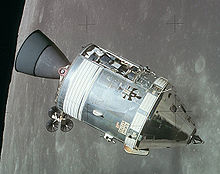
Wernher von Braun had advocated for NASA to develop a space station since the agency was created. In 1973, Following the end of the Apollo lunar missions NASA launched its first space station, Skylab, on the final launch of the Saturn V. Skylab repurposed a significant amount of former Apollo and Saturn hardware, with a repurposed Saturn V third stage serving as primary module for the space station. Damage to Skylab during launch required spacewalks by the first crew to make it habitable and operational. Skylab only hosted 9 missions and was decommissioned in 1974 and deorbited in 1979, two years prior to the Space Shuttle's launch and any possibility of boosting its orbit. [12]
In 1975, the Apollo–Soyuz mission was the first ever international spaceflight and a major diplomatic accomplishment between the Cold War rivals. Flown in 1975, a U.S. Apollo spacecraft docked with a Soviet Soyuz capsule. It also was the last flight of the Apollo capsule.[13]
Interplanetary exploration and space science
[edit]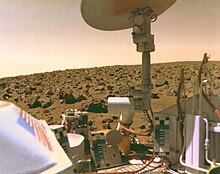
During the 1960s, NASA started its space science and interplanetary probe program. The Mariner program was its flagship program, launching probes to Venus, Mars, and Mercury in the 1960s. The Jet Propulsion Laboratory was the lead NASA center for robotic interplanetary exploration, making significant discoveries about the inner planets. Despite these successes, Congress was unwilling to fund further interplanetary missions and NASA Administrator James Webb suspended all future interplanetary probes to focus resources on the Apollo program.[14]
Following the conclusion of the Apollo program, NASA resumed launching interplanetary probes and expanded its space science program. The first planet tagged for exploration was Venus, sharing many similar characteristics to Earth. First visited by American Mariner 2 spacecraft, Venus was observed to be a hot and inhospitable planet. Follow-on missions included the Pioneer Venus project in the 1970s and Magellan, which performed radar mapping of Venus' surface in the 1980s and 1990s. Future missions were flybys of Venus, on their way to other destinations in the Solar System.[15]
Mars has long been a planet of intense fascination for NASA, being suspected of potentially having harbored life. Mariner 5 was the first NASA spacecraft to flyby Mars, followed by Mariner 6 and Mariner 7. Mariner 9 was the first orbital mission to Mars. Launched in 1975, Viking program consisted of two landings on Mars in 1976. Follow-on missions would not be launched until 1996, with the Mars Global Surveyor orbiter and Mars Pathfinder, deploying the first Mars rover, Sojourner. During the early 2000s, the 2001 Mars Odyssey orbiter reached the planet and in 2004 the Sprit and Opportunity rovers landed on the Red Planet. This was followed in 2005 by the Mars Reconnaissance Orbiter and 2007 Phoenix Mars lander. The 2012 landing of Curiosity discovered that the radiation levels on Mars were equal to those on the International Space Station, greatly increasing the possibility of Human exploration, and observed the key chemical ingredents for life to occur. In 2013, the Mars Atmosphere and Volatile EvolutioN (MAVEN) mission observed the Martian upper atmospher and space environment and in 2018, the Interior exploration using Seismic Investigations Geodesy, and Heat Transport (InSight) studied the Martian interior. The 2021 Perseverance rover carried the first extraplanetary aircraft, a helicopter named Ingenuity.[16]

NASA also launched missions to Mercury in 2004, with the MESSENGER probe demonstrating as the first use of a solar sail. NASA also launched probes to the outer solar system starting in the 1960s. Pioneer 10 was the first probe to the outer planets, flying by Jupiter, while Pioneer 11 provided the first close up view of the planet. Both probes became the first objects to leave the Solar System. The Voyager program launched in 1977, conducting flybys of Jupiter and Saturn, Neptune, and Uranus on a trajectory to leave the Solar System. The Galileo spacecraft, deployed from the Space Shuttle flight STS-34, was the first spacecraft to orbit Jupiter, discovering evidence of subsurface oceans on the Europa and observed that the moon may hold ice or liquid water. A joint NASA-European Space Agency-Italian Space Agency mission, Cassini–Huygens, was sent to Saturn's moon of Titan, which along with Mars and Europa, are the only objects non-Terran objects in the Solar System suspected of being capable of harboring life. Cassini discovered three new moons of Saturn and the Huygens probe entered Titan's atmosphere. The mission discovered evidence of liquid hydrocarbon lakes on Titan and subsurface water oceans on the moon of Enceladus, which could harbor life. Finally launched in 2006, the New Horizons mission was the first spacecraft to visit Pluto and the Kuiper Belt.[17]
Beyond interplanetary probes, NASA has a long tradition of launching space telescopes. Launched in the 1960s, the Orbiting Astronomical Observatory were NASA's first orbital telescopes, providing ultraviolet, gamma-ray, x-ray, and infrared observations. Not just looking up, NASA launched the Orbiting Geophysical Observatory to look down at Earth and observe its interactions with the Sun. The Uhuru satellite was the first dedicated x-ray telescope, mapping 85% of the sky and discovering a large number of black holes.[18]

Launched in the 1990s and early 2000s, the Great Observatories program are among NASA's most powerful telescopes. The Hubble Space Telescope was launched in 1990 on STS-31 from the Discovery and could view galaxies 15 light years away. A major defect in the telescope's mirror could have cripped the program, had NASA not used computer enhancement to compensate for the imperfection and launched five Space Shuttle servicing flights to replace the damaged components. The Compton Gamma Ray Observatory was launched from the Atlantis on STS-37 in 1991, discovering a possible source of antimatter at the center of the Milky Way and observing that the majority of gamma-ray bursts occur outside of the Milky Way galaxy. The Chandra X-ray Observatory was launched from the Columbia on STS-93 in 1999, observing black holes, quasars, supernova, and dark matter. It provided critical observations on the Sagittarius A* black hole at the center of the Milky Way galaxy and the separation of dark and regular matter during galactic collisions. Finally, the Spitzer Space Telescope is an infrared telescope and the last of the great observatories, launched in 2003 from a Delta II rocket. It is in a trailing orbit aroud the Sun, following the Earth and discovered the existance of brown dwarf stars.[19]
Other telescopes, such as the Cosmic Background Explorer and the Wilkinson Microwave Anisotropy Probe, provided evidence to support the Big Bang. The James Webb Space Telescope, named after the NASA administrator who lead the Apollo program, is an infrared observatory launched in 2021. The James Webb Space Telescope is a direct successor to the Hubble Space Telescope, intended to observe the formation of the first galaxies. Other space telescopes include the Kepler space telescope, launched in 2009 to identify planets orbiting extrasolar stars that may be Terran and possibly harbor life. The first exoplanet that the Keplar space telescope confirmed was Kepler-22b, orbiting within the habitable zone of its star.[20]
NASA also launched a number of different satellites to study Earth, such as Television Infrared Observation Satellite (TIROS) in 1960, which was the first weather satellite. NASA and the United States Weather Bureau cooperated on future TIROS and the second generation Nimbus program of weather satellites. It also worked with the Environmental Science Services Administration on a series of weather satellites and the agency launched its the experimental Applications Technology Satellites into geosynchronous orbit. NASA's first dedicated Earth observation satellite, Landsat, was launched in 1972. This led to NASA and the National Oceanic and Atmospheric Administration jointly developing the Geostationary Operational Environmental Satellite and discovering Ozone depletion.[21]
The Space Shuttle
[edit]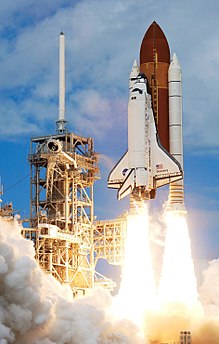
NASA had been perusing spaceplanes since the 1960s, blending the administration's dual aeronautics and space missions. NASA viewed a spaceplane as part of a larger program, providing routine and economical logistical support to a space station in Earth orbit that would be used as a hub for lunar and Mars missions. A reusable launch vehicle would end the need for expensive and expendable boosters like the Saturn V.[22]
In 1969, NASA designated the Johnson Space Center as the lead center for developing the design, development, and manufacturing of the Space Shuttle orbiter, while the Marshall Space Flight Center would lead the development of the launch system. NASA's series of lifting body aircraft, culminating in the joint NASA-U.S. Air Force Martin Marietta X-24, directly informed the development of the Space Shuttle and future hypersonic flight aircraft. Official development of the Space Shuttle began in 1972, with Rockwell International contracted to design the orbiter and engines, Martin Marietta for the external fuel tank, and Morton Thiokol for the solid rocket boosters. NASA acquired six orbiters: the Enterprise, Columbia, Challenger, Discovery, Atlantis, and Endeavour[23]
The Space Shuttle program also allowed NASA to make dramatic changes to its Astronaut Corps. While almost all previous astronauts were Air Force or Naval test pilots, the Space Shuttle allowed NASA to begin recruiting more non-military scientific and technical experts. A prime example is Sally Ride, who became the first American woman to fly in space on STS-7. It also allowed NASA to accept exchange astronauts from U.S. allies and partners for the first time.[24]
The first Space Shuttle flight occurred in 1981, when the Columbia launched on the STS-1 mission, designed to serve as a flight test for the new spaceplane. NASA intended for the Space Shuttle to replace expendable launch systems like the Air Force's Atlas, Delta, and Titan and the European Space Agency's Ariane. The Space Shuttle's Spacelab payload, developed by the European Space Agency, dramatically increased the scientific capabilities of shuttle missions over anything NASA was able to previously accomplish.[25]
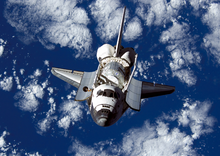
NASA launched its first commercial satellites on the STS-5 mission and in 1984, the STS-41-C mission conducted the world's first on-orbit satellite servicing mission when the Challenge captured and repaired the malfunctioning Solar Maximum Mission satellite. It also had the capability to return malfunctioning satellite to Earth, like it did with the Palapa B2 and Westar 6 satellites. Once returned to Earth, the satellites were repaired and relaunched.[26]
Despite ushering in a new era of spaceflight, where NASA was contracting launch services to commercial companies, the Space Shuttle was criticized for not being as reusable and cost-effective as advertised. In 1986, Challenger disaster on the STS-51L mission resulted in the loss of the spacecraft and all seven astronauts on launch, grounding the entire space shuttle fleet for 36 months and forced the 44 commercial companies that contracted with NASA to deploy their satellites to return to expendable launch vehicles. When the Space Shuttle returned to flight with the STS-26 mission, it had undergone significant modifications to improve its reliability and safety.[27]
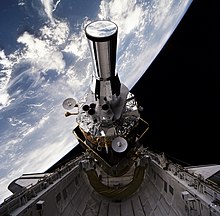
Following the collapse of the Soviet Union, the Russian Federation and United States initaited the Shuttle-Mir program. The first Russian cosmonaut flew on the STS-60 mission in 1994 and the Discovery rendezvoused, but did not dock with, the Russian Mir in the STS-63 mission. This was followed by Atlantis' STS-71 mission where it accomplished the initial intended mission for the Space Shuttle, docking with a space station and transferring supplies and personnel. The Shuttle-Mir program would continue until 1998, when a series of orbital accidents on the space station spelled an end to the program.[28]
In 2003, a second space shuttle was lost when the Columbia was lost upon reentry during the STS-107 mission, resulting in the loss of the spacecraft and all seven astronauts. This accident marked the beginning of the end of the Space Shuttle program, with President George W. Bush directing that upon the completion of the International Space Station, the space shuttle be retired. In 2006, the Space Shuttle returned to flight and flew several additional missions, flying several mission to service the Hubble Space Telescope, but was retired with the completion of the completion of the STS-135 resupply mission to the International Space Station in 2011.
Space stations
[edit]
NASA never gave up on the idea of a space station after Skylab's reentry in 1979. The agency began lobbing politicians to support building a space station as soon as the Space Shuttle began flying, selling it as an orbital laboratory, repair station, and a jumping off point for lunar and Mars missions. NASA found a strong advocate in President Ronald Reagan, who declared in a 1984 speech:
"America has always been greatest when we dared to be great. We can reach for greatness again. We can follow our dreams to distant stars, living and working in space for peaceful, economic, and scientific gain. Tonight I am directing NASA to develop a permanently manned space station and to do it within a decade.
In 1985, NASA proposed the Space Station Freedom, which both the agency and President Reagan intended to be an international program. While this would add legitimacy to the program, there were concerns within NASA that the international component would dilute its authority within the project, having never been willing to work with domestic or international partners as true equals. There was also a concern with sharing sensitive space technologies with the Europeans, which had the potential to dilute America's technical lead. Ultimately, an international agreement to develop the Space Station Freedom program would be signed with thirteen countries in 1985, including the European Space Agency member states, Canada, and Japan.[29]
Despite its status as the first international space program, the Space Station Freedom was controversial, with much of the debate centering on cost. Several redesigns to reduce cost were conducted in the early 1990s, stripping away much of its functions. However, despite calls for Congress to terminate the program it continued, in large part because by 1992 it had created 75,000 jobs across 39 states. By 1993, President Bill Clinton attempted to significantly reduce NASA's budget and directed costs be significantly reduced, aerospace industry jobs were not lost, and the Russians be included.[30]

In 1993, the Clinton Administration announced that the Space Station Freedom would become the International Space Station in an agreement with the Russian Federation. This allowed the Russians to maintain their space program through an infusion of American currency to maintain their status as one of the two premier space programs. While the United States built and launched the majority of the International Space Station, Russia, Canada, Japan, and the European Space Agency all contributed components. Despite NASA's insistence that costs would be kept at a budget of $17.4, they kept rising and NASA had to transfer funds from other programs to keep the International Space Station solvent. Ultimately, the total cost of the station was $150 billion, with the United States paying for two-thirds.Following the Space Shuttle Columbia disaster in 2003, NASA was forced to rely on Russian Soyuz launches for its astronauts and the 2011 retirement of the Space Shuttle accelerated the station's completion. [31]
In the 1980s, right after the first flight of the Space Shuttle, NASA started a joint program with the Department of Defense to develop the Rockwell X-30 National Aerospace Plane. NASA realized that the Space Shuttle, while a massive technological accomplishment, would not be able to live up to all its promises. Designed to be a single-stage-to-orbit spaceplane, the X-30 had both civil and military applications. With the end of the Cold War, the X-30 was canceled in 1992 before reaching flight status.[32]
Unleashing commercial space and return to the Moon
[edit]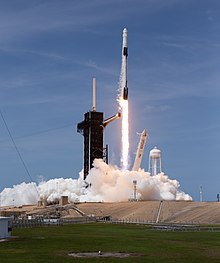
Following the 2003 Space Shuttle Columbia disaster, President Bush started the Constellation program to smoothly replace the Space Shuttle and expand space exploration beyond low Earth orbit. Constellation was intended to use a significant amount of former Space Shuttle equipment and return astronauts to the Moon. However, the Constellation program was canceled by the Obama Administration and former astronauts Neil Armstrong, Gene Cernan, and Jim Lovell sent a letter to President Barrack Obama to warn him that if the United States did not get new human spaceflight ability, the U.S. risked become a second or third-rate space power.[33]
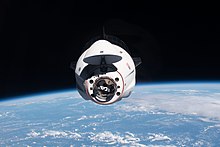
As early as the Reagan Administration, there had been calls for NASA to expand private sector involvement in space exploration rather than do it all in house. In the 1990s, NASA and Lockheed Martin entered into an agreement to develop the Lockheed Martin X-33 and VentureStar spaceplane, which was intended to replace the Space Shuttle. However, due to technical challenges the spacecraft was cancelled in 2001. Despite this, it was the first time a commercial space company directly expended a significant amount of its own resources into spacecraft development. The advent of space tourism also forced NASA to challenge its assumption that only governments would have people in space. The first space tourist was Dennis Tito, an American investment manager and former aerospace engineer who contracted with the Russians to fly to the International Space Station for four days, despite the opposition of NASA to the idea.[34]

Advocates of this new commercial approach for NASA included former astronaut Buzz Aldrin, who remarked that it would return NASA to its roots as a research and development agency, with commercial entities actually operating the space systems. Having corporations take over orbital operations would also allow NASA to focus all its efforts on deep space exploration and returning humans to the Moon and going to Mars. Embracing this approach, NASA's Commercial Crew Program started by contracting cargo delivery to the International Space Station and flew its first operational contracted mission on SpaceX Crew-1. This marked the first time since the retirement of the Space Shuttle that NASA was able to launch its own astronauts on an American spacecraft from the United States, ending a decade of reliance on the Russians.[35]
In 2019, NASA announced the Artemis program, intending to return to the Moon and establish a permanent human presence. [36] This was paired with the Artemis Accords with partner nations to establish rules of behavior and norms of space commercialization on the Moon.[37]
Organization
[edit]As an independent agency, the administrator of NASA reports directly to the president of the United States. The administrator is nominated by the president of the United States and confirmed by the United States Senate.Cite error: A <ref> tag is missing the closing </ref> (see the help page).
Centers and facilities
[edit]| Name | Mission | Headquarters | |
|---|---|---|---|
| Centers | |||
| Ames Research Center | Information technology, fundamental aeronautics, biology, and space science technologies[38] | Moffett Federal Airfield, California | |
| Armstrong Flight Research Center | Flight research and test[39] | Edwards Air Force Base, California | |
| Glenn Research Center | Aeropropulsion and communications technology[40] | Brook Park, Ohio | |
| Goddard Space Flight Center | Earth, solar system, and universe observations, and space communications and navigation | Greenbelt, Maryland | |
| Jet Propulsion Laboratory | Robotic exploration of the solar system and Earth observations | La Cañada Flintridge, California | |
Personnel and culture
[edit]Symbols
[edit]Astronaut Corps
[edit]Awards and decorations
[edit]- ^ https://www.nasa.gov/sites/default/files/atoms/files/2022_nasa_strategic_plan.pdf
- ^ https://www.nasa.gov/sites/default/files/atoms/files/naca_to_nasa_to_now_tagged.pdf
- ^ https://www.nasa.gov/sites/default/files/atoms/files/naca_to_nasa_to_now_tagged.pdf
- ^ https://www.nasa.gov/sites/default/files/atoms/files/naca_to_nasa_to_now_tagged.pdf
- ^ https://www.nasa.gov/sites/default/files/atoms/files/naca_to_nasa_to_now_tagged.pdf
- ^ https://www.nasa.gov/sites/default/files/atoms/files/naca_to_nasa_to_now_tagged.pdf
- ^ https://www.nasa.gov/sites/default/files/atoms/files/naca_to_nasa_to_now_tagged.pdf
- ^ https://www.nasa.gov/sites/default/files/atoms/files/naca_to_nasa_to_now_tagged.pdf
- ^ https://www.nasa.gov/sites/default/files/atoms/files/naca_to_nasa_to_now_tagged.pdf
- ^ https://www.nasa.gov/sites/default/files/atoms/files/naca_to_nasa_to_now_tagged.pdf
- ^ https://www.nasa.gov/sites/default/files/atoms/files/naca_to_nasa_to_now_tagged.pdf
- ^ https://www.nasa.gov/sites/default/files/atoms/files/naca_to_nasa_to_now_tagged.pdf
- ^ https://www.nasa.gov/sites/default/files/atoms/files/naca_to_nasa_to_now_tagged.pdf
- ^ https://www.nasa.gov/sites/default/files/atoms/files/naca_to_nasa_to_now_tagged.pdf
- ^ https://www.nasa.gov/sites/default/files/atoms/files/naca_to_nasa_to_now_tagged.pdf
- ^ https://www.nasa.gov/sites/default/files/atoms/files/naca_to_nasa_to_now_tagged.pdf
- ^ https://www.nasa.gov/sites/default/files/atoms/files/naca_to_nasa_to_now_tagged.pdf
- ^ https://www.nasa.gov/sites/default/files/atoms/files/naca_to_nasa_to_now_tagged.pdf
- ^ https://www.nasa.gov/sites/default/files/atoms/files/naca_to_nasa_to_now_tagged.pdf
- ^ https://www.nasa.gov/sites/default/files/atoms/files/naca_to_nasa_to_now_tagged.pdf
- ^ https://www.nasa.gov/sites/default/files/atoms/files/naca_to_nasa_to_now_tagged.pdf
- ^ https://www.nasa.gov/sites/default/files/atoms/files/naca_to_nasa_to_now_tagged.pdf
- ^ https://www.nasa.gov/sites/default/files/atoms/files/naca_to_nasa_to_now_tagged.pdf
- ^ https://www.nasa.gov/sites/default/files/atoms/files/naca_to_nasa_to_now_tagged.pdf
- ^ https://www.nasa.gov/sites/default/files/atoms/files/naca_to_nasa_to_now_tagged.pdf
- ^ https://www.nasa.gov/sites/default/files/atoms/files/naca_to_nasa_to_now_tagged.pdf
- ^ https://www.nasa.gov/sites/default/files/atoms/files/naca_to_nasa_to_now_tagged.pdf
- ^ https://www.nasa.gov/sites/default/files/atoms/files/naca_to_nasa_to_now_tagged.pdf
- ^ https://www.nasa.gov/sites/default/files/atoms/files/naca_to_nasa_to_now_tagged.pdf
- ^ https://www.nasa.gov/sites/default/files/atoms/files/naca_to_nasa_to_now_tagged.pdf
- ^ https://www.nasa.gov/sites/default/files/atoms/files/naca_to_nasa_to_now_tagged.pdf
- ^ https://www.nasa.gov/sites/default/files/atoms/files/naca_to_nasa_to_now_tagged.pdf
- ^ https://www.nasa.gov/sites/default/files/atoms/files/naca_to_nasa_to_now_tagged.pdf
- ^ https://www.nasa.gov/sites/default/files/atoms/files/naca_to_nasa_to_now_tagged.pdf
- ^ https://www.nasa.gov/sites/default/files/atoms/files/naca_to_nasa_to_now_tagged.pdf
- ^ https://www.space.com/artemis-program.html
- ^ https://www.nasa.gov/specials/artemis-accords/index.html
- ^ https://www.nasa.gov/about/org_index.html
- ^ https://www.nasa.gov/centers/armstrong/about/afrc-overview.html
- ^ https://www.nasa.gov/about/org_index.html
